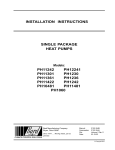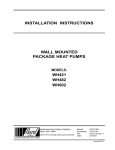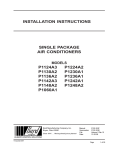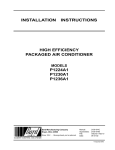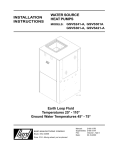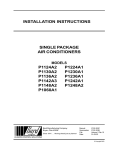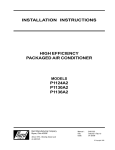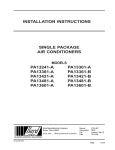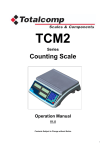Download Bard PH1230 Troubleshooting guide
Transcript
INSTALLATION INSTRUCTIONS SINGLE PACKAGE HEAT PUMPS MODELS PH1224 PH1230 PH1236 Bard Manufacturing Company Bryan, Ohio 43506 Since 1914...Moving ahead, just as planned. Manual : File: Date: 2100-344 Volume II Tab 11 08-21-98 © Copyright 1998 Contents Getting Other Informations and Publications ........ 1 General Instructions ................................................. Important ................................................................ Shipping Damage .................................................... General ................................................................ Field-Installed Heater Packages (Optional) .............. 3 3 3 3 3 Installation ................................................................. 5 Location ................................................................ 5 Typical Installations .................................................. 5 Condensate Drain Trap ............................................ 8 Air Filters ................................................................ 8 Wiring – Main Power ................................................ 9 Wiring – 24V Low Voltage Control Circuit ................ 9 Thermostats ........................................................... 10 Thermostat Indicator Lamps ................................... 11 Emergency Heat Position ....................................... 11 Transformer Taps .................................................... 11 Compressor Cut-Off Thermostat and Outdoor Thermostat Wiring .................................................. 11 Start Up and Operation .......................................... Three Phase Scroll Compressor Start Up Information ............................................................. Sequence of Operation .......................................... Defrost Cycle ......................................................... Start Up Notes ....................................................... 12 12 12 12 12 Service and Troubleshooting ................................ 14 Service Hints .......................................................... 14 Pressure Service Ports .......................................... 14 Refrigerant Charge ................................................ 14 Fan Blade Settings ................................................. 14 Solid State Heat Pump Control Troubleshooting Procedure .................................... 14 Troubleshooting Guide ........................................... 15 Checking Temperature Sensor Check Out ............. 16 Temperature vs. Resistance of Temperature Sensor Chart ..................................... 16 Suction and Discharge Tube Brazing ..................... 17 Pressure Tables ..................................................... 18 Wiring Diagrams ............................................. 19 - 21 Figures Figure 1 Figure 2 Figure 3 Figure 4 Figure 5 Figure 6 Figure 7 Figure 8 Figure 9 Figure 10 Figure 11 Figure 12 Figure 13 Prefabricated Rood Curb Specifications .......................................... 4 Field Fabricated Curbing ......................... 4 Elevated Mounting Platforms .................. 6 Airflow and Service Access Clearances .............................................. 6 Roof Top Application ............................... 7 Slab Mounting at Ground Level ............... 7 Condensate Drain Trap ........................... 8 Low Voltage Wiring ................................. 9 Compressor Cut-Off Thermostat Wiring (5 and 10 KW) ............................ 11 Compressor Cut-Off Thermostat Wiring )15 KW ONLY) ........................... 11 Heat Pump Control Board ..................... 13 Fan Blade Setting Dimensions .............. 14 Brazing Diagram ................................... 17 Tables Table 1 Table 2 Electrical Data ......................................... 2 Optional Field Installed Heater Packages ................................................ 2 Table 3 Optional Field Installed Heater Table ....... 2 Table 4 Rated CFM and Rated ESP .................... 3 Table 5 Air Filter Area and Size ........................... 8 Table 6 Thermostat Wire Size ............................. 9 Table 7 Heat Pump Thermostats ....................... 10 Table 8 Volts, KW and Phase - Compressor Cut-Off Wiring (5 and 10 KW) ............... 11 Table 9 Volts, KW and Phase - Compressor Cut-Off Wiring (15 KW ONLY0 ............. 11 Table 10 Refrigerant Charge ............................... 14 Table 11 Pressure Table - Cooling ....................... 18 Table 12 Pressure Table - Heating ....................... 18 Getting Other Information and Publications These publications can help you install the air conditioner or heat pump. You can usually find these at your local library or purchase them directly from the publisher. Be sure to consult current edition of each standard. National Electrical Code ........................... ANSI/NFPA 70 Standard for the Installation ...................... ANSI/NFPA 90A of Air Conditioning and Ventilating Systems Standard for Warm Air ............................. ANSI/NFPA 90B Heating and Air Conditioning Systems Load Calculation for ................................. ACCA Manual J Residential Winter and Summer Air Conditioning Duct Design for Residential ...................... ACCA Manual D Winter and Summer Air Conditioning and Equipment Selection Commercial Low Pressure, ....................... ACCA Manual Q Low Velocity Duct System Design Load Calculation For Commercial ............ ACCA Manual N Summer and Winter Air Conditioning For more information, contact these publishers: ACCA — Air Conditioning Contractors of America 1712 New Hampshire Ave. N.W. Washington, DC 20009 Telephone: (202) 483-9370 Fax: (202) 234-4721 ANSI — American National Standards Institute 11 West Street, 13th Floor New York, NY 10036 Telephone: (212) 642-4900 Fax: (212) 302-1286 ASHRAE — American Society of Heating Refrigerating, and Air Conditioning Engineers, Incorporated 1791 Tullie Circle, N.E. Atlanta, GA 30329-2305 Telephone: (404) 636-8400 Fax: (404) 321-5478 NFPA — National Fire Protection Association Batterymarch Park P.O. Box 9101 Quincy, MA 02269-9901 Telephone: (800) 344-3555 Fax: (617) 984-7057 Manual 2100-344 Page 1 TABLE 1 ELECTRICAL DATA Q R Maximum External Fuses or Ckt. Brk. Minimum Circuit Ampacity Field Power Wiring Ground Wire Size Ckt. A Ckt. A Ckt. A Ckt. A R Rated Volts & Phases Operating Voltage Range Maximum Unit Amps PH1224 230/208-1 197 - 253 14.4 25 18 10 10 PH1230 230/208-1 197 - 253 17.7 30 22 10 10 PH1236 230/208-1 197 - 253 21.8 40 27 8 8 PH1236-B 230/208-3 197 - 253 15.6 25 19 10 10 Model Q R Maximum time delay fuse or HACR type circuit breaker. HACR type not applicable to 460 volt. 75 degree C cooper wire size, basic unit only. TABLE 2 OPTIONAL FIELD INSTALLED HEATER PACKAGES ONLY TO BE USED WITH THE HEAT PUMP MODELS INDICATED Heater Package Volts and Model No. Phase EH3PC-A05 EH3PB-A10 EH3PC-A10 EH3PC-A15 240/1 EH3PB-B09 EH3PB-B15 240/3 PH1224 PH1230 PH1236 X X X X X X X PH1236-B X X X TABLE 3 OPTIONAL FIELD-INSTALLED ELECTRIC HEATER TABLE Htr. KW & Capacity @ 240V (or 480V if applicable) Circuit B Htr. KW & Capacity @ 208 Volts @ 240V R Q S or 480V as Heater No. Minimum Maximum Field Ground applicable Internal Field Circuit Overcurrent Power Wire Htr. Amps Fuses Ckts. Ampacity Protection Wiring Size Heater Pkg. Model Unit Volts No. Phase KW BT UH KW BT UH EH3PB-A10 240/208-1 10 34,100 7.50 26,000 41.7 1 53 60 6 10 EH3PC-A05 240/208-1 EH3PC-A10 240/208-1 EH3PC-A15 240/208-1 5 10 15 17,100 3.75 34,100 7.50 51,200 11.25 12,800 26,000 38,400 20.8 41.7 62.5 1 1 1 26 53 79 30 60 80 10 6 4 10 10 8 EH3PB-B09 240/208-3 EH3PB-B15 240/208-3 9 15 30,700 6.75 51,200 11.25 23,000 38,400 21.7 36.2 1 1 28 46 30 50 10 8 10 10 Q R S IMPORTANT: 30/60 Time delay fuses or “HACR” type circuit breakers must be used for 60 and smaller sizes. Standard fuses or circuit breakers are suitable for sizes 70 and larger. 480V circuit breakers are not “HACR” type. Based on wire suitable for 75° C. Other wiring materials must be rated for marked “Minimum Circuit Ampacity” or greater. Based upon Table 250-95 of N.E.C. 1993. See electrical data for basic heat pump for Circuit A wiring specification requirements. While this electrical data is presented as a guide, it is important to electrically connect properly size fuses and conductor wires in accordance with the National Electrical Code and all existing local codes. Manual 2100-344 Page 2 GENERAL INSTRUCTIONS IMPORTANT The equipment covered in this manual is to be installed by trained, experienced service and installation technicians. Any heat pump is more critical of proper operating charge and an adequate duct system than a straight air conditioning unit. All duct work, supply and return ducts, must be properly sized for the design air flow requirement of the equipment. ACCA is an excellent guide to proper sizing. All duct work or portions thereof not in the conditioned space should be properly insulated in order to both conserve energy and prevent condensation or moisture damage. SHIPPING DAMAGE Upon receipt of equipment, the carton should be checked for external signs of shipping damage. If damage is found, the receiving party must contact the last carrier immediately, preferably in writing, requesting inspection by the carrier’s agent. FIELD INSTALLED HEATER PACKAGES (OPTIONAL) These packaged heat pumps are manufactured without supplementary electric heaters. Supplementary heaters EH3P series (to fit PH1224, PH1230, and PH1236) are available for simple, fast, field installation. A separate field power circuit is required for the supplementary heaters. IMPORTANT: Refer to Table 4 when designing duct work for maximum available static pressure with heater installed. Refer to the electrical data shown on pages 2 and 3 for proper application information on all available heater combinations and what units they can be used with. It also shows the applicable circuit ampacities, fuse size, and wire size for each heater combination. Refer to the installation instructions packed with the heater for details on how to insert it into the basic unit. GENERAL The refrigerant system is completely assembled and charged. All internal wiring is complete. The unit is designed for use with or without duct work. Flanges are provided for attaching the supply and return ducts. These instructions explain the recommended method to install the air cooled self-contained unit and the electrical wiring connections to the unit. These instructions and any instructions packaged with any separate equipment required to make up the entire heat pump system should be carefully read before beginning the installation. Note particularly “Starting Procedure” and any tags and/or labels attached to the equipment. TABLE 4 RATED CFM AND EXTERNAL STATIC PRESSURE (ESP) WET COIL (COOLING) Model Rated CFM Rated ESP Recommended Air Flow Range PH1224 800 .20 680 - 880 CFM PH1230 1000 .30 775 - 1100 CFM PH1236 1100 .20 775 - 1210 CFM While these instructions are intended as a general recommended guide, they do not supersede any national and/or local codes in any way. Authorities having jurisdiction should be consulted before the installation is made. Manual 2100-344 Page 3 FIGURE 1 PREFABRICATED ROOF CURB SPECIFICATIONS HEAVY GAUGE GALVANIZED WITH WOOD NAILING STRIP, WELDED/LEAKPROOF ONE PIECE CONSTRUCTION – READY TO INSTALL MIS-1177 CURB AND ROOF DETAILS Roof Curb A 9042-003 80-3/8 B C* D E F J* H* Roof Hood Model 40-1/4 37-1/4 38-3/8 35-3/8 42 14-3/4 19-1/8 RHE60 *Duct Sizing Information Return Air Dimension “C” is length Return Air Dimension “H” is width Air Conditioning Units PH1224, PH1230, PH1236 Supply Air Dimension “C” is length Supply Sir Dimension “J” is width FIGURE 2 FIELD FABRICATED CURBING MIS-1178 Manual 2100-344 Page 4 Roof Hood Model Unit Model E RHE36 PH1224 PH1230 PH1236 41 INSTALLATION LOCATION TYPICAL INSTALLATIONS GENERAL 1. ROOF MOUNTED – The unit is mounted on a sturdy base on the roof of the building. Return air to the unit is brought through a single return grille (grilles with built-in filters are best since they enable easy access for filter changing). Return air ducts are attached to the lower section of the front panel. Supply air is brought from the unit to attic duct work or to a furred down hall. Supply air duct is attached to the top of the front panel. The unit must be located outside, or in a well ventilated area. It must not be in the space being heated or cooled. A sound absorbing material should be considered if the unit is to be installed in such a position or location that might cause transmission of sound or vibration to the living area or adjacent buildings. SLAB MOUNTING In areas where winter temperatures DO NOT go below 32° F for periods over twelve hours, the unit may be slab mounted at grade level. When installing unit at grade level, install on a concrete slab at least four inches above finished grade level. Slab should have a slope tolerance away from the building structure of at lease 1/4 inch per foot, while being level from side to side. This will prevent ice buildup under the unit during defrost cycles. Place slab in a location where runoff water from higher ground will not collect around unit. See Figure 3. A minimum of 18 inches should be provided between the coil inlet and any building surfaces. Provide at least four feet between coil outlet and any building wall, fences or other vertical structures. Provide a minimum of three feet clearance on the service access side of the unit. See Figure 4 ROOF MOUNTING When a unit is installed in areas where low ambient temperatures or strong winter winds exist, it should be placed so prevailing winter winds are not in direct line with the heat pump coil. If this is not possible, a wind barrier should be constructed. Place barrier 24 inches from the coil inlet side of the unit and in the direction of prevailing winds. Size barrier at least the same height and width as the unit. This may be necessary on ground level installations, also. See Figure 5. WINTER INSTALLATION BELOW 32°F In areas where winter conditions go below 32°F for extended periods, the unit must be elevated above the mounting surface to prevent snowfall or defrost ice accumulation from interfering with the operation of the unit. A minimum of twelve inch elevation is recommended, while greater elevation may be required for areas of high snow accumulation. Poured concrete, steel framework, brick, cement block, etc., can be utilized to construct a suitable raised mounting platform. See Figure 6. DUCT WORK Refer to Tables 4, 5 and 5A when designing duct work for maximum static pressure available with the specific model and heater package being installed. Unit duct work is suitable for 0” clearance to combustible materials. CAUTION: All outdoor duct work must be thoroughly insulated and weatherproofed. All attic duct work must be thoroughly insulated. Two inch thick insulation with suitable vapor barrier is recommended for both outdoor and attic runs. In roof top installation, as in all installations, the heat pump must be level from side to side. However, the unit should have a pitch along the length to assure complete external drainage of precipitation and of defrost condensate. 2. CRAWL SPACE – Duct work installed in crawl space must be well insulated and provided with a vapor barrier. In addition, the crawl space must be thoroughly ventilated and provided with a good vapor barrier as a ground cover. It is most desirable to install the unit outdoors rather than inside the crawl space, so that it will be readily accessible for service. In addition, it is necessary to dispose of the condensate from the outdoor coil on the heating cycle, and this is virtually impossible with the unit installed inside the crawl space. 3. SLAB MOUNTED AT GROUND LEVEL – This type installation is ideal for homes with a slab floor construction where a roof mounted unit is not desired. The supply and return duct work can be run through a furred closet space. 4. THROUGH THE WALL – This type installation requires a suitable framework to be fabricated capable of withstanding the unit weight. Normally the unit will be insulated so as to minimize supply and return duct work. 5. OTHER INSTALLATIONS – Many other installations are possible with the packaged heat pump. No matter what the installation, always consider the following facts: A. Insure that the discharge air is not obstructed in any way so as to cause operation difficulties. B. The indoor coil drain pan is equipped with a coupling that must be piped through a condensate drain trap to a suitable drain. C. Always mount the unit is such a position that it may be easily reached for servicing and maintenance. D. Insure that the unit is clear so that proper air flow over the outdoor coil will be maintained. If this unit is operated in cooling below a 65° outdoor ambient temperature, the installation of low ambient controls (CMA-6) to unit is required. Manual 2100-344 Page 5 FIGURE 3 ELEVATED MOUNTING PLATFORMS MIS-1183 FIGURE 4 AIRFLOW and SERVICE ACCESS CLEARANCES MIS-1185 Manual 2100-344 Page 6 FIGURE 5 ROOF TOP APPLICATION (May also be required for ground level installations.) MIS-1176 FIGURE 6 SLAB MOUNTING AT GROUND LEVEL (Above 32° F Outside Temperature) MIS-1184 Manual 2100-344 Page 7 CONDENSATE DRAIN TRAP It is very important to provide a trap in the condensate drain line to allow a positive liquid seal in the line and assure correct drainage from the coil condensate pan. Install condensate drain trap shown in Figure 7. Use drain connection size or larger. Do not operate unit without trap. Unit must be level or slightly inclined toward drain. With a trap installed on a unit located in an unconditioned area, water in the trap may freeze. It is recommended that the trap material be of a type that will allow for expansion of water when it freezes. AIR FILTERS Air filters for the return air side of the system are not provided as part of the various types of applications for these models, and must be field supplied and installed as part of the final installation. Prior thought should be given to return air location and placement of the air filter(s). The air filter(s) must be of adequate size and readily accessible to the operator of the equipment. Filters must be adequate in size and properly maintained for proper operation. If this is not done, excessive energy use, poor performance, and multiple service problems will result. It is impossible to oversize air filters. Generous sizing will result in cleaner air and coils as well as lower operating costs and extend the time between required changes. Table 6 shows minimum filter areas and recommended filter sizes. Actual filter sizes can vary with the installation due to single or multiple returns utilizing a filter/grille arrangement or being placed immediately ahead of the indoor coil face in the return air duct. TABLE 5 Model PH1224 PH1230 PH1236 Minimum Filter Areas Recommended Size 462 square inches (3.21 square feet) 15 x 30-5/8 x 1 NOTE: If roof hood accessory is to be used, information on air filters may be found under that heading in this manual. Air filters are supplied as part of that package. FIGURE 7 CONDENSATE DRAIN TRAP MIS-136 Manual 2100-344 Page 8 WIRING – MAIN POWER Refer to the unit rating plate for wire sizing information and maximum fuse size. Each outdoor unit is marked with a “Minimum Circuit Ampacity”. This means that the field wiring used must be sized to carry that amount of current. If field installed heaters are added to the basic unit, a second separate power supply circuit will be required. The heater rating plate located adjacent to the basic unit rating plate will show the appropriate circuit ampacity fuse size, etc. (Also see “Electrical Data” on pages 2.) All models are suitable for connection with copper wire only. These instructions must be adhered to. Refer to the National Electrical Code for complete current carrying capacity data on the various insulation grades of wiring material. WIRING – 24V LOW VOLTAGE CONTROL CIRCUIT Ten (10 ) wires should be run from thermostat subbase to the 24V terminal board in the unit. A ten conductor, 18 gauge copper, color-coded thermostat cable is recommended. The connection points are shown in Figure 8. FIGURE 8 – LOW VOLTAGE WIRING The electrical specifications on page 2 lists fuse and wire sizes (75° F copper) for all models including the most commonly used heater sizes. The unit rating plate lists a “Maximum Time Delay Fuse” or “HACR” type circuit breaker that is to be used with the equipment. The correct size must be used for proper circuit protection and also to assure that there will be no nuisance tripping due to the momentary high starting current of the compressor. MIS-1187 TABLE 6 – THERMOSTAT WIRE SIZE Transformer VA FLA 55 2.3 Wire Gauge Maximum Length In Feet 20 18 16 14 12 45 60 100 160 250 Manual 2100-344 Page 9 THERMOSTATS See specific wiring information for the different models, heater KWs, and voltages. TABLE 7 HEAT PUMP THERMOSTATS T HERMOSTAT SUBBASE DESCRIPT ION 8403-045 (T841A1761) Part of Thermostat 1 stage cool, 2 stage heat; Mecury bulb; Manual changeover Fan Switch: Auto-On; System Switch: Em Heat-Heat-Off-Cool Indicating Lamps: Check-Em Heat-Aux Heat 8403-017 (T874R1129) 8404-009 Q674L1181 1 stage cool, 2 stage heat; Mercury bulb; Manual changeover Fan Switch: Auto-On; System Switch: Em Heat-Heat-Off-Cool Indicating Lamps: Check-Em Heat Q 8403-018 (T874N1024) 8404-010 Q674F1261 1 stage cool, 2 stage heat; Mercury bulb; Auto changeover Fan Switch: Auto-On; System Switch: Off-Em Heat-Heat-Auto-Cool Indicating Lamps: Check-Em Heat R 8403-042 (T8511G1070) Part of Thermostat 1 stage cool, 2 stage heat; Digital non-programmable (no battery required) Automatic or manual changeover Fan Switch: Auto-On; System Switch: Off-Em Heat-Auto or Cool/Heat Indicating Lamps: Check Display Indication: Em Heat-Aux Heat 8403-034 (1F94-80) Part of Thermostat 2 stage cool, 2 stage heat; Digital programmable (7 day); Battery backup Automatic or manual changeover; 1 set-up/set-back period per 24 hours Programmable ventilation terminal for economizer or energy recovery Fan Switch: Auto-On; System Switch: Off-Em Heat-Auto or Cool/Heat Indicating Lamps: Emer-Pump-Malf-Aux 8403-027 (1F92-71) Part of Thermostat 2 stage cool, 3 stage heat; Digital proframmable (5day/2day); Battery backup Automatic or manual changeover: 4 set-ups/set-back periods per 24 hours Fan Switch: Auto-On; System Switch: Off-Em Heat-Auto or Cool/Heat Indicating Lamps: Emer-Pump-Malf-Aux Q No automatic changeover position – must be manually placed in heat or cool. Reversing valve remains energized at all times system switch is in heat position (except during defrost cycle). No pressure equalization noise when thermostat is satisfied on either heating or cooling. R Allows thermostat to control both heating and cooling operation when set in “AUTO” position. Reversing valve deenergizes at end of each “ON” heating cycle. Manual 2100-344 Page 10 THERMOSTAT INDICATOR LAMPS The red lamp marked “EM. HT.” comes on and stays on whenever the system switch is placed in Em. Ht. position. The green lamp marked “Check” will come on if there is any problem that prevents the compressor from running when it is supposed to be. COMPRESSOR CUTOFF THERMOSTAT WIRING (5 and 10 KW) FIGURE 9 UNIT 24V TERMINAL BOARD EMERGENCY HEAT POSITION The operator of the equipment must manually place the system switch in this position. This is done when there is a known problem with the outdoor section, or when the green “Check” lamp comes on indicating a problem. TRANSFORMER TAPS 230/208V, 1 phase and 3 phase equipment employ dual primary voltage transformers. All equipment leaves the factory wired on 240V tap. For 208V operation, reconnect from 240V to 208V tap. The acceptable operating voltage range for the 240 and 208V taps are: TAP RANGE 240 253 – 216 208 220 – 187 NOTE: The voltage should be measured at the field power connection point in the unit and while the unit is operating at full load (maximum amperage operating condition). COMPRESSOR CUTOFF THERMOSTAT and OUTDOOR THERMOSTAT WIRING Heat pump compressor operation at outdoor temperatures below 0° F are neither desirable nor advantageous in terms of efficiency. Since most equipment at time of manufacture is not designated for any specific destination of the county and most of the equipment is installed in areas not approaching the lower outdoor temperature range, the compressor cutoffs are not factory installed. Outdoor thermostats are available to hold off various banks of electric heat until needed as determined by outdoor temperature. The set point of either type of thermostat is variable with geographic region and sizing of the heating equipment to the structure. Utilization of the Heating Application Data and the heat loss calculation of the building are useful in determining the correct set points. REMOVE FACTORY JUMPER Y-Y1 MIS-1188 OUTDOOR THERMOSTAT USED AS COMPRESSOR CUTOFF TABLE 8 5 and 10 KW Model KW Volts Phase PH1224 0, 5, 10 230 1 PH1230 0, 5, 10 230 1 PH1236 0, 5, 10 230 1 COMPRESSOR CUTOFF THERMOSTAT WIRING (15 KW ONLY) FIGURE 10 UNIT 24V TERMINAL BOARD REMOVE FACTORY JUMPER Y-Y1 MIS-1189 OUTDOOR THERMOSTAT USED AS COMPRESSOR CUTOFF TABLE 9 15 KW ONLY Model KW Volts Phase PH1230 15 230 1 PH1236 15 230 1 Manual 2100-344 Page 11 START UP AND OPERATION THREE PHASE SCROLL COMPRESSOR START UP INFORMATION Scroll compressors, like several other types of compressors, will only compress in one rotational direction. Direction of rotation is not an issue with single phase compressors since they will always start and run in the proper direction. However, three phase compressors will rotate in either direction depending upon phasing of the power. Since there is a 50-50 chance of connecting power in such a way as to cause rotation in the reverse direction, verification of proper rotation must be made. Verification of proper rotation direction is made by observing that suction pressure drops and discharge pressure rises when the compressor is energized. Reverse rotation also results in an elevated sound level over that with correct rotation, as well as, substantially reduced current draw compared to tabulated values. Verification of proper rotation must be made at the time the equipment is put into service. If improper rotation is corrected at this time there will be no negative impact on the durability of the compressor. However, reverse operation for over one hour may have a negative impact on the bearing due to oil pump out. NOTE: If compressor is allowed to run in reverse rotation for several minutes the compressor’s internal protector will trip. All three phase ZR*3 compressors are wired identically internally. As a result, once the correct phasing is determined for a specific system or installation, connecting properly phased power leads to the same Fusite terminals should maintain proper rotation direction. The direction of rotation of the motor may be changed by reversing any two line connections to the unit. SEQUENCE OF OPERATION COOLING – Circuit R-Y makes at thermostat pulling in compressor contactor starting the compressor and outdoor motor. The G (indoor motor) circuit is automatically completed on any call for cooling operation, or can be energized by manual fan switch on subbase for constant air circulation. HEATING – A 24V solenoid coil on reversing valve controls heating cycle operation. Two thermostat options, one allowing “AUTO” changeover from cycle to cycle and the other constantly energizing solenoid coil during heating season and thus eliminating pressure equalization noise except during defrost, are to be used. On “AUTO” option, a circuit is completed from R-W1 and R-Y on each heating “On” cycle energizing reversing valve solenoid and pulling in compressor contactor starting compressor and outdoor motor. R-G also make starting indoor blower motor. Heat pump heating cycle now in operation. The second energizes Manual 2100-344 Page 12 the reversing valve solenoid constantly whenever the system switch on subbase is placed in “Heat” position, the “B” terminal being constantly energized from R. A thermostat demand for heat completes R-Y circuit, pulling in compressor contactor starting compressor and outdoor motor. R-G also make starting indoor blower motor. DEFROST CYCLE The defrost cycle is controlled by temperature and time on the solid state heat pump control. When the outdoor temperature is in the lower 40° F temperature range or colder, the outdoor coil temperature is 32°F or below. This temperature is sensed by the coil sensor mounted near the bottom of the outdoor coil. Once the coil temperature reaches 32°F or below, the coil sensor sends a signal to the control logic of the heat pump control and defrost timer will start. After 60 (90 or 30) minutes at 32°F or below, the heat pump control will place the system in the defrost mode. During the defrost mode, the refrigerant cycle switches back to the cooling cycle, the outdoor motor stops, electric heaters are energized, and hot gas passing through the outdoor coil melts any accumulated frost. When the temperature rises to approximately 57° F, the coil sensor will send a signal to the heat pump control which will return the system to heating operations automatically. If some abnormal or temporary condition such as a high wind causes the heat pump to have a prolonged defrost cycle, the heat pump control will restore the system to heating operation automatically after 10 minutes. There are three settings on the heat pump control -- 30 minutes, 60 minutes, and 90 minutes. Most models are shipped wired on the 60 minutes setting for greatest operating economy. If special circumstances require a change to another time, remove wire connected to terminal 60 and reconnect to desired terminal. (See Figure 11.) There is a cycle speed up jumper on the control. This can be used to reduce the time between defrost cycle operation without waiting for time to elapse. There is an initial defrost (sen jmp) jumper on the control that can be used at any outdoor ambient during the heating cycle to simulate a 0° coil temperature. This can be used to check defrost operation of the unit without waiting for the outdoor ambient to fall into the defrost region. START UP NOTES For improved start up performance, wash the indoor coil with dishwasher detergent FIGURE 11 HEAT PUMP CONTROL BOARD MIS-1191 Manual 2100-344 Page 13 SERVICE AND TROUBLESHOOTING SERVICE HINTS 1. Caution homeowner to maintain clean air filters at all times. Also, not to needlessly close off supply and return air registers. This reduces air flow through the system which shortens equipment service life as well as increasing operating costs. 2. Switching to heating cycle at 75° F or higher outside temperature may cause a nuisance trip of the manual reset high pressure switch. 3. The heat pump wall thermostats perform multiple functions. Be sure that all function switches are correctly set for the desired operating mode before trying to diagnose any reported service problems. FIGURE 12 FAN BLADE SETTING DIMENSIONS Model Dimension A PH1224 PH1230 PH1236 1.00" .75" .75" 4. Check all power fuses or circuit breakers to be sure that they are the correct rating. 5. Periodic cleaning of the outdoor coil to permit full and unrestricted airflow circulation is essential. MIS-1190 PRESSURE SERVICE PORTS High and low pressure service ports are installed on all units so that the system operating pressures can be observed. Pressure tables can be found in Tables 11 and 12 in this manual covering all models on both cooling and heating cycles. It is imperative to match the correct pressure table to the unit by model number. SOLID STATE HEAT PUMP CONTROL TROUBLESHOOTING PROCEDURE REFRIGERANT CHARGE 3. Turn thermostat blower switch to Auto position. Indoor blower should stop. The correct system R-22 charge is shown on the unit rating plate. Optimum unit performance will occur with a refrigerant charge resulting in a suction line temperature (6” from compressor) as shown in Table 10. 1. Turn on AC power supply to indoor and outdoor units. 2. Turn thermostat blower switch to fan on. The indoor blower should start. (If it doesn’t, troubleshoot indoor unit and correct problem.) 4. Set system switch to heat or cool. Adjust thermostat to call for heat or cool. The indoor blower, compressor, and outdoor fan should start. TABLE 10 Model Rated Airflow 95 Degree F OD Temperature 82 Degree F OD Temperature PH1224 PH1230 PH1236 800 1000 1100 56 - 56 56 - 56 50 - 52 61 - 62 58 - 60 52 - 54 The above suction line temperatures are based upon 80° F dry bulb/67° F wet bulb (50% RH) temperature and rated airflow across the evaporator during cooling cycle. FAN BLADE SETTINGS Shown in Figure 12 are the correct fan blade setting dimensions for proper air delivery across the outdoor coil. Any service work requiring removal or adjustment in the fan and/or motor area will require that the dimensions in Figure 12 be checked and blade adjusted in or out on the motor shaft accordingly. Manual 2100-344 Page 14 NOTE: If there is no power to 24 volt transformer, the compressor and outdoor fan motor will not start for 5 minutes. This is because of the compressor short cycle protection. TROUBLE SHOOTING GUIDE Symptom Compressor contactor does not energize (heating or cooling) Fan outdoor motor does not run (cooling or heating except during defrost) Possible Causes What to Check How to Check or Repair Contil circuit wiring Check for R connection at unit Run R connection to outdoor unit to power heat and 24 volt between R-C. pump control. Compressor lock out 1. Check for 24V between 1. If no voltage between L1-C, turn thermostat off L1-C on heat pump control and on again to reset high pressure switch. 2. Check across high 2. If high pressure switch is open and will not reset, pressure switch. replace high pressure switch. Compressor short cycle protection Check for 24V between CC-C If no voltage between CC-C, jumper speed up and Y -C on heat pump terminal, and within 10 seconds power should control. appear between CC-C. Remove speed up jumper after 10 seconds. Heat pump control defective Check all other possible causes. Manual 2100-065. Replace heat pump control. Contactor defective Check for open or shorted coil winding. Replace contactor. Motor defective Check for open or shorted motor winding. Replace motor. Motor capacitor defective Check capacitor rating. Check for open or shorted capacitor. Replace capacitor. Heat pump control defective Check across fan relay on heat pump control. (Com-NC) Replace heat pump control. Reversing valve does not energize (heating only) Reversing volve solenoid coil defective Check for open or shorted coil. Replace solenoid coil. Heat pump control defective Check for 24V between RV-C 1. Check control circuit wiring. and B-C. 2. Replace heat pump control Unit will not go into defrost (heating only) Temperature sensor or heat pump control defective Disconnect temperature sensor from board and jumper across speed up terminals and sen jump terminals. This should cause the unit to go through a defrost cycle within one minute. Unit will not come out of defrost (heating only) Temperature sensor or heat pump control defective. 1. If unit goes through defrost cycle, replace temperature sensor. 2. If unit does not go through defrost cycle, replace heat pump control. Jumper across speed up 1. If unit comes out of defrost cycle, replace terminals. This should cause temperature sensor. the unit to come out of defrost 2. If unit does not come out of defrost cycle, within one minute. replace heat pump control. Manual 2100-344 Page 15 CHECKING TEMPERATURE SENSOR CHECK OUT 3. Check resistance reading to chart of resistance; use sensor ambient temperature. (Tolerance of part is ± 10%.) 1. Disconnect temperature sensor from board and from outdoor coil. 4. If sensor resistance reads very low, then sensor is shorted and will not allow proper operation of the heat pump control. 2. Use an ohmmeter and measure the resistance of the sensor. Also use ohmmeter to check for short or open. 5. If sensor is out of tolerance, shorted, open, or reads very low ohms then it should be replaced. TEMPERATURE F vs RESISTANCE R OF TEMPERATURE SENSOR F -25.0 R 196871 F R F 15.0 53640 55.0 R 17434 F R 95.0 6531 -24.0 190099 16.0 52051 56.0 16984 96.0 6383 -23.0 183585 17.0 50514 57.0 16547 97.0 6239 6098 -22.0 177318 18.0 49028 58.0 16122 98.0 -21.0 171289 19.0 47590 59.0 15710 99.0 5961 -20.0 165487 20.0 46200 60.0 15310 100.0 5827 -19.0 159904 21.0 44855 61.0 14921 101.0 5697 -18.0 154529 22.0 43554 62.0 14544 102.0 5570 -17.0 149355 23.0 42295 63.0 14177 103.0 5446 -16.0 144374 24.0 41077 64.0 13820 104.0 5326 -15.0 139576 25.0 39898 65.0 13474 105.0 5208 -14.0 134956 26.0 38757 66.0 13137 105.0 5094 -13.0 130506 27.0 37652 67.0 12810 107.0 4982 -12.0 126219 28.0 36583 68.0 12492 108.0 4873 -11.0 122089 29.0 35548 69.0 12183 109.0 4767 -10.0 118108 30.0 34545 70.0 11883 110.0 4663 Manual 2100-344 Page 16 -9.0 114272 31.0 33574 71.0 11591 111.0 4562 -8.0 110575 32.0 32634 72.0 11307 112.0 4464 -7.0 107010 33.0 31723 73.0 11031 113.0 4367 -6.0 103574 34.0 30840 74.0 10762 114.0 4274 -5.0 100260 35.0 29986 75.0 10501 115.0 4182 -4.0 97064 36.0 29157 76.0 10247 116.0 4093 -3.0 93981 37.0 28355 77.0 10000 117.0 4006 -2.0 91008 38.0 27577 78.0 9760 118.0 3921 -1.0 88139 39.0 26823 79.0 9526 119.0 3838 0.0 85371 40.0 26092 80.0 9299 120.0 3757 1.0 82699 41.0 25383 81.0 9077 121.0 3678 2.0 80121 42.0 24696 82.0 8862 122.0 3601 3.0 77632 43.0 24030 83.0 8653 123.0 3526 4.0 75230 44.0 23384 84.0 8449 124.0 3452 5.0 72910 45.0 22758 85.0 8250 6.0 70670 46.0 22150 86.0 8057 7.0 68507 47.0 21561 87.0 7869 8.0 66418 48.0 20989 88.0 7686 9.0 64399 49.0 20435 89.0 7507 10.0 62449 50.0 19896 90.0 7334 11.0 60565 51.0 19374 91.0 7165 12.0 58745 52.0 18867 92.0 7000 13.0 56985 53.0 18375 93.0 6840 14.0 55284 54.0 17898 94.0 6683 • SUCTION AND DISCHARGE TUBE BRAZING Compliant Scroll compressors have copper plated steel suction and discharge tubes. These tubes are far more rugged and less prone to leaks than copper tubes used on other compressors. Due to different thermal properties of steel and copper, brazing procedures may have to be changed from those commonly used. • To disconnect: heat joint Areas 2 and 3 slowly and uniformly until braze material softens and the tube can be pulled out of suction fitting. (See Figure 10.) To connect: – Recommended brazing materials: silfos with minimum 5% silver or silver braze material with flux. – Reinsert tube into fitting. – Heat tube uniformly in Area 1 moving slowly to Area 2. When joint reaches brazing temperature, apply brazing material. (See Figure 10.) – Heat joint uniformly around the circumference to flow braze material completely around the joint. – Slowly move torch into Area 3 to draw braze material into joint. (See Figure 10.) – Do not overheat joint. FIGURE 13 BRAZING DIAGRAM MIS-1179 Manual 2100-344 Page 17 PRESSURE TABLES TABLE 11 COOLING Air Temperature Entering Outdoor Coil Degrees F Model PH1224 PH1230 PH1236 Return Air Temperature Pressure 75 80 85 90 95 100 105 110 115 75 deg. DB 62 deg. WB Low Side High Side 73 191 75 205 76 219 78 234 79 251 80 267 81 285 82 303 83 323 80 deg. DB 67 deg. WB Low Side High Side 78 196 80 210 81 225 83 240 84 257 88 274 87 292 88 311 89 331 85 deg. DB 72 deg. WB Low Side High Side 81 203 83 217 84 233 86 248 87 266 89 284 90 302 91 322 92 343 75 deg. DB 62 deg. WB Low Side High Side 73 208 75 222 76 237 78 254 79 270 79 288 81 307 82 326 84 346 80 deg. DB 67 deg. WB Low Side High Side 78 213 80 228 81 243 83 260 84 277 85 295 87 315 88 334 90 355 85 deg. DB 72 deg. WB Low Side High Side 81 220 83 236 84 252 86 269 87 287 88 305 90 326 91 346 93 367 75 deg. DB 62 deg. WB Low Side High Side 72 211 74 225 75 242 77 258 78 276 79 294 80 314 81 333 82 355 80 deg. DB 67 deg. WB Low Side High Side 77 216 79 231 80 248 82 265 83 283 84 302 86 322 87 342 88 364 85 deg. DB 72 deg. WB Low Side High Side 80 224 82 239 83 257 85 274 86 293 87 313 89 333 90 354 91 377 TABLE 12 HEATING Air Temperature Entering Outdoor Coil Degrees F Model Return Air Temp. Pressure 0 5 10 15 17 20 25 31 33 37 201 205 213 30 35 40 45 47 50 PH1224 70 deg Low Side High Side 22 24 27 30 174 182 190 198 PH1230 70 deg Low Side High Side 21 23 25 28 29 31 34 38 43 48 53 55 59 65 167 170 174 178 179 182 187 192 197 203 210 213 217 224 PH1236 70 deg Low Side High Side 24 25 26 194 195 197 28 28 30 201 202 205 41 45 50 56 58 62 221 229 237 245 248 253 55 68 261 33 37 42 47 53 56 60 68 211 218 226 235 246 250 257 270 Low side pressure ± 2 PSIG High side pressure ± 5 PSIG Tables are based upon rated CFM (airflow across the evaporator coil and should be found under section titled “Refrigerant Charge” elsewhere in manual. If there is any doubt as to correct operating charge being in the system, the charge should be removed, system evacuated, and recharged to serial plate instructions. Manual 2100-344 Page 18 Wiring Diagram (4098-123) printed from CAD to get size needed Manual 2100-344 Page 19 Wiring Diagram (4098-124) printed from CAD to get size needed Manual 2100-344 Page 20 Wiring Diagram (4098-211) printed from CAD to get size needed Manual 2100-344 Page 21























